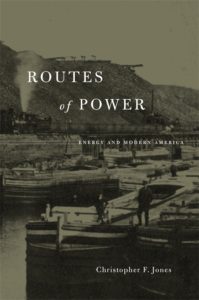 The fossil fuel revolution is usually rendered as a tale of historic advances in energy production. In this perspective-changing account, I instead tell a story of advances in energy access: canals, pipelines, and wires that delivered power in unprecedented quantities to cities and factories at a great distance from production sites. I show that in the American mid-Atlantic region between 1820 and 1930, the construction of elaborate transportation networks for coal, oil, and electricity unlocked remarkable urban and industrial growth along the eastern seaboard. But this new transportation infrastructure did not simply satisfy existing consumer demand; it also whetted an appetite for more abundant and cheaper energy, setting the nation on a path toward fossil fuel dependence.
The fossil fuel revolution is usually rendered as a tale of historic advances in energy production. In this perspective-changing account, I instead tell a story of advances in energy access: canals, pipelines, and wires that delivered power in unprecedented quantities to cities and factories at a great distance from production sites. I show that in the American mid-Atlantic region between 1820 and 1930, the construction of elaborate transportation networks for coal, oil, and electricity unlocked remarkable urban and industrial growth along the eastern seaboard. But this new transportation infrastructure did not simply satisfy existing consumer demand; it also whetted an appetite for more abundant and cheaper energy, setting the nation on a path toward fossil fuel dependence.
Today, those who wish to pioneer a more sustainable and egalitarian energy order can learn valuable lessons from this history of the nation’s first steps toward dependence on fossil fuels.
Routes of Power was awarded the Edelstein Prize for best book by the Society for the History of Technology.
Buy from Amazon.
Buy from Harvard University Press.
Reviews
“Working at the intersection of technological and environmental history, Jones shows that understanding political economy and social context are integral to understanding energy transitions. His elegantly written and cogently argued narrative of how Americans spent down the planetary savings account of solar energy amassed in fossil fuels is as compelling as a mystery novel.”–Ann Norton Greene, Journal of Interdisciplinary History
“Jones rethinks our understanding of the history of energy … Routes of Power provides a picture of America’s energy history that is new, concrete, innovative, and persuasive.” –”Martin V. Melosi, author of Atomic Age America
“Jones’s ambitious book deftly balances the particular and general [and] will likely have a big impact on the quickly growing subfield of energy history.” –Brian Leech, H-Net Reviews
“Routes of Power is an admirably well-organized and well-written monograph, deftly balancing empirical data with story-driven interpretation. The book is a pleasure to read from start to finish.” –Paul Hirt, Enterprise & Society